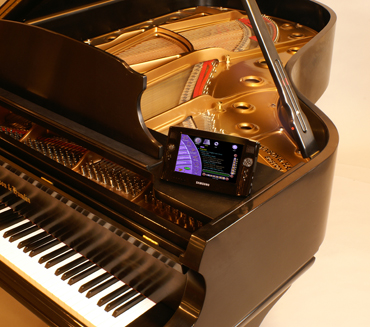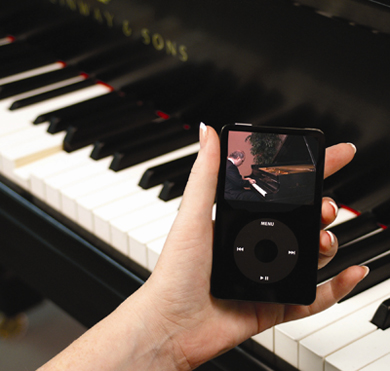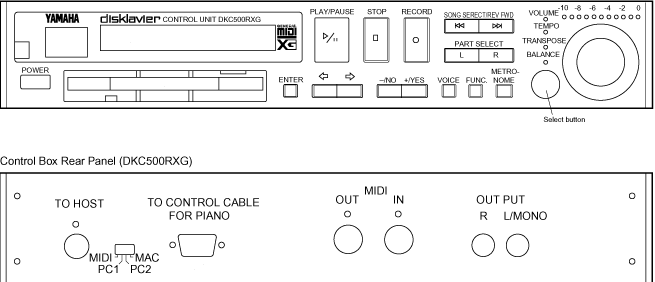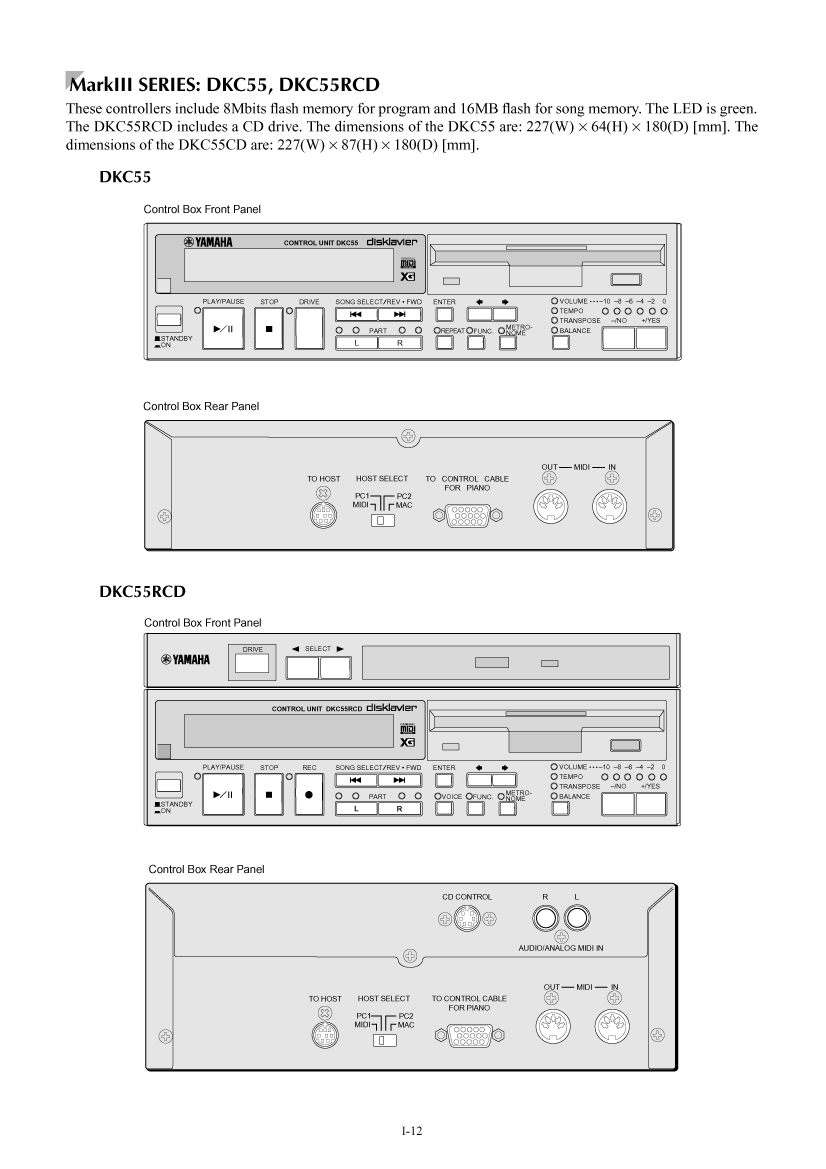


MIDI Players
Pianocorder
Pianocorder Library
PianoDisc
QRS Pianomation
Yamaha Disklavier
Advice on Buying a Disklavier
High Resolution MIDI Players and LX Software
Live Performance LX
Music sharing is a testament to life as no creature sings to itself. Beyond the creation and performance of the song; it is human nature to want to capture that performance and ultimately to reproduce and distribute it. It is no small wonder that mechanical devices were invented to play stored music.
During the 19th century, the player piano had become the instrument of choice with its vast library of paper player rolls, and by 1900, 1 in 3 households owned one. They were powered by air long before electricity was available. A foot-driven bellows provided air to the motor; which distributed a smooth flow of air to a tracker bar where a paper roll with holes was read.



Soon, people wanted to hear more than just the tune, they wanted to hear the expression of the artist’s recording. That touched off the past 100 years of trying to reproduce an exact piano performance in one’s own living room. Three air-driven systems improved the expression of the piano roll music, the Welte Mignon in Germany, the Duo-Art and Ampico systems in the U.S.
Once electricity became widely used, the quest was on to expand the quality and distribution of reproducible music into people’s homes. Finally in the early 1970’s Teledyne developed a solenoid-based player piano system using magnetic tape for storage. Teledyne sold a few systems, but it was never fully implemented.
All MIDI Players of today and yesterday, in some way or another, owe their existence to one brilliant engineer, Wayne Stahnke of Los Angeles., CA. What is even more glorious is that he is alive and well today as the developer of the Live Performance LX systems used in the Zenph Studios Re-Performances. He is both the beginning and the end of MIDI Players as we know them today. His first solenoid based player system from the 1970s was developed into a more sophisticated version in the 1980s. It had 1024 levels of expression and was marketed by Kimball International as the Bosendorfer SE Computer Based Piano Performance Reproduction System in the 1980’s. Until his LX system, it was believed by many to be the finest reproducing system ever constructed. Thirty seven of these systems were built into Bosendorfer grand pianos and controlled by dedicated IBM computers using serial interfaces. They were mostly owned by colleges and universities and too expensive for home use.
From 1991 to 2001 Mr. Stahnke worked for Yamaha as part of the team that developed the Disklavier Pro. Some of his patents are also found on the non-Pro Disklaviers. In 1992 he founded Live Performance. His translation of piano rolls recorded by Sergei Rachmaninoff in 1998 and 1999 became a 2-CD set called "A Window in Time" on the Telarc label, and was a milestone in player piano history
. He is also the inventor of the Live Performance Model LX player system which combines techniques developed and refined over the past 30 years in combination with new technology developed by Zenph Studios.For more information and the science behind the technology, visit: http://www.live-performance.com Thank you, Mr. Stahnke!
The Pianocorder Reproducing System
I owe a great deal to Mark Fontana’s Master’s Thesis, Preservation and
MIDI Translation of the Pianocorder Music Library, 1997 for the information
in this section. It is available on his website listed above. or
HERE
![]()
In 1977, Joseph Tushinsky, chairman of Superscope, a home audio equipment company that specialized in tape recorder technology, was interested in developing a commercially available solenoid based player system. Since he and Wayne Stahnke could not come to agreement for developing a commercial product, Superscope purchased the design rights from the earlier system developed by Teledyne. The Pianocorder Reproducing System was sold under the Marantz brand name. It was a revolutionary product and one of the first commercial player piano systems to use magnetic storage medium and digital electronics. The Pianocorder library also marked the first effort to convert piano rolls to digital format.
Not only did Pianocorder market an internally-installed model player system, they also produced an external "Vorsetzer" model that could be pushed up to play a piano as well the pedals. There were 80 pinball machine solenoids using rubber-tipped plungers hanging down above the keys and two long rods (not pictured) that connected to the pedals. I owned two of these and often wish that something like it was available today. They were so versatile. I used one to "break-in" pianos that I had rebuilt in my shop, and the other one was used on whatever piano was in the living room. I often put one into a van and took to play other pianos off site. Certainly made for some interesting church socials!

Unfortunately, Vorsetzers are now a thing of the past. Below is pictured an old piano roll type, then a Pianocorder Vorsetzer pushed up to a grand piano.


The last vorsetzer model I know of, was the QRS Playola. I will admit that for as useful as this thing could have been, it was marketed very poorly. It was also the ugliest piece of technology I ever saw.

Joseph Tushinsky was also an avid collector of reproducing player rolls, amassing a huge collection of over 18,000 piano rolls. In 1967 he began playing them for the public on a popular series of radio broadcasts entitled Keyboard Immortals Play Again – In Stereo. Once he acquired Pianocorder he started having some of his collection of piano rolls translated into the digital Pianocorder format onto cassette tapes to form the basis of the Pianocorder library. Superscope produced approximately 350 tapes for the Pianocorder system, each holding about 40 minutes of music. Nineteen of the 30 volumes were produced by scanning piano rolls on equipment at Superscope and translating them into Pianocorder digital cassette format. The other 11 Pianocorder volumes contain material recorded live at Superscope in the late 1970s and early 1980s. These recordings were probably made on regular Pianocorder system equipped with the recording option sold by Superscope; the wire switch and microphone system originally designed by Teledyne. The Superscope engineers edited and cleaned up these recordings, and produced cassette tapes containing a variety of show tunes, jazz standards, romantic medleys, and popular hits of the 1970s.
Yamaha bought Pianocorder in 1987, along with the patents to the electronic systems, so they could take it off the market and give their new Disklavier a clear field with no competition. They also acquired the music library. With the exception of the celebrity recordings, Yamaha took little action to preserve the music library or convert it for use with the Disklavier system. After the Pianocorder system was discontinued, Tuchinsky’s collection of piano rolls was reportedly purchased by a Japanese business man who took them to Tokyo. Soon the collection was returned to the U.S. and auctioned off in Los Angeles.
Yamaha licensed the duplication of the Pianocorder cassette tapes to QRS, but the tapes eventually wear out. The original masters acquired from Marantz in the form of 8-inch floppy disks, are in storage at Yamaha’s facility in Japan. Thankfully, enough private collectors since then have lent their cassettes to the private project of converting the Pianocorder library to standard MIDI files. The entire Pianocorder library can fit on one CD. Yamaha eventually marketed some of the music, but mostly it is available from private sources.
Pianocorder was a popular love affair in the digital piano music world, and its demise produced profound grief. The system was the ultimate musical heritage machine. It brought 80 years of Americana and world classics right into your living room and anywhere else you wanted to take it. American ingenuity quickly rose to the situation and two new electronic player systems were invented, the PianoDisc and the QRS Pianomation. These systems could be retrofit into any piano, as opposed to the Disklavier, which was only available as a factory installation in a Yamaha piano. By then the MIDI standard was in place, so both new systems used it for their music libraries. To continue the digitization of the old paper piano rolls that were decaying, roll scanners were developed, and their designs freely distributed so that vast collections of player piano rolls could be converted to standard MIDI files for free distribution.
Market-based music production can be devastating to musical heritage. My grateful thanks to those who do the work of music preservation, re-creation and re-performance – and make it available to all of us!
Two brothers, Gary and Kirk Burgett started a retail piano business in Sacramento, California in 1979. By 1988, about 40% of their business was sales and installations of Pianocorder player systems. When Yamaha bought Pianocorder and took it off the market, they decided to meet the challenge of developing their own player system. They produced their first system in March of 1989 and over the years many generations of PianoDisc player systems have been introduced; each one expanding the capabilities and features of the last.
PianoDisc player systems are retrofit systems – they can be installed in any piano. Their current Silent Drive system offers 1024 levels of expression and uses flash memory to store music. The iQ Intelligent Player systems offer wireless control by various external devices including iPad, iPad, MP3, players, and smart phones. Besides the basic system that actually plays your piano keys, everything else they sell is an add-on, optional component. Among the accessories offered is a tone generator, a TFT record strip installed under the keyboard for MIDI output as well as silent operation with headphones, CD wireless, AirTurn automatic page turner, powered speakers, and PianoSync which allows for playback of the piano with hit CDs.
 Opus 7
and iQ models
Opus 7
and iQ models

To support their product, a music library was needed. The company began recording some of the world’s finest pianists, and over the years more than 4000 songs in every category of music have been recoded for PianoDisc. Their library is still growing. Note: newer models of PianoDisc systems require a propriety music format. They will convert your old PianoDisc music to the new format for free. See their website, listed above, for details.
Pianodisc also offers FREE 24/7 Streaming Internet Radio exclusively for their iQ systems at: http://pianodisc.streamguys.tv/listen.pls Refer to their document,
iQHowTo: Streaming Internet Radio
They also put all the User’s Manuals on their website as well as very good descriptions of all their products. My own experience with these systems has been very good as they seldom break and the company has excellent technical support. The only concern is that one hopes the person doing the installation of the player system was diligent and knew what they were doing. PianoDisc has no control over how their units are installed except for the ones they do themselves on Mason & Hamlin pianos. You can also see the manuals HERE
www.qrsmusic.com
QRS was founded in 1900 by Melville Clark (of Story & Clark piano fame) who developed the player piano which was popular until the 1930s. QRS supplied music rolls to the player piano production peaking in 1927, when they sold 10 million rolls. Even though The Great Depression and the invention of radio gave rise to the demise of the player piano, the demand for rolls continued and was reinvigorated in the 1950s when people began restoring old player pianos. QRS remains the only manufacturer of piano rolls in the world today. To view a video on how QRS piano rolls are made,
click here to see the YouTube video.In 1986, QRS began focusing on new technologies, and in 1989 released its first digital retrofit player piano kit under the Pianomation™ name. Today QRS is an industry leader in introducing fun innovations in home musical entertainment. QRS Music Technologies became a public company in 1996.
The QRS Pianomation player system is also a retrofit system that is designed to be installed in any piano. They produce a PNOSCAN MIDI Record strip, a tone generator and capability to play MIDI files from CDs and MP3 players. The Ancho is the top of the line QRS Player system: http://qrsmusic.com/pianomation-p.asp?pid=3371
and their most popular is the Petine:
They also have the largest music library in the world thanks to their manufacturing of piano rolls since 1900, with about 45,000 titles. Their website is excellent as it provides the user and technical manuals for all of their products. They also provide excellent customer service and technical support. Manuals HERE
The new Pianomation II system was released in June
2011.
Details
![]()
Yamaha Disklavier and Disklavier Pro
www.usa.yamaha.com
The Yamaha Disklavier was introduced in 1986. All models of the Disklavier are factory installed into Yamaha pianos in Japan. There are no retrofit systems. All models have both record and playback capabilities except the MarkIII playback only series on two grand piano models, the DGA1 and DGP1. They are the finest MIDI recording pianos over the PianoDisc and QRS Pianomation systems.
Here is a list of Disklaviers and their respective functions prior to the
MarkIII introduced in 2000 and now discontinued.
Disklavier Models Comparison of Functions
![]()
MX100A was the first upright Disklaviers on the market in 1987. It had Record and Playback.

MX100B was the same model, but with a mute function and volume control down to -7 in 1990.
DGP was the first Wagon Grand Disklavier in 1989. It had half pedal and self calibration.

MX80 was a Record and Playback box on top of a console piano.

These early model Disklaviers can only play ESEQ format (Yamaha proprietary) music files from 720k floppy disks. They do play standard MIDI files thru a MIDI interface. They are only upgradeable with the discontinued DSR-1 control box.
MarkII Series was introduced in 1992. Half pedal recording and playback.
It can be updated with either the
DSR-1, or by adding the DKC-850 control box.

MarkIIXG came out in 1997. It has a built-in XG tone generator and flash memory. Support for 1.44 MB floppy disks and standard MIDI files. Has a To Host port on rear of control box. System software can be updated from a floppy disk. Mark IIXG Owners Manuals

The MarkIII series came in 3 categories:
1. Playback only: DGA1, DGP1
2. Record & Playback with CD drive (no hammer sensors): DGH1A, DGA1A, DGC1, DC2A
3. Record & Playback with CD drive (hammer sensors): DC3,5,6,and 7A
MarkIII Disklaviers had a Silent feature, transposable audio, came with
60watt speakers and 2 amplifiers, had 16MB memory disks, Smart Key and played
PianoSoft plus Audio CD. They are upgradeable to internet radio with the DKC-850
hardware upgrade.
Mark III Owners
Manuals
![]()

Mark IV Series Disklaviers are one current model. They have an 80GB hard drive and can be remotely controlled with various handheld devices. See more details on Yamaha’s website: http://usa.yamaha.com/products/musical-instruments/keyboards/
MarkIV Owners Manuals
E3 Series of Disklaviers is the latest model. They use the DKV-850
control box which has 128 MB of internal memory, FromToPc Folder, and Disklavier
Internet Radio.
E3 Owners Manual
![]()

Yamaha Disklavier Hardware Upgrades and Software Updates
Only two hardware upgrades have been available: the DSR-1 Control Box (which is discontinued) and the new DKC-850 Control box introduced in 2010. The original equipment Disklavier Control Boxes are NOT interchangeable between models! Because the new DKC-850 replaces the control box on some models, the original ones are appearing on eBay. If you can find the discontinued DSR-1 Control Box, it will upgrade the MX100A/B and MarkII Disklavier models. The also discontinued DCD1 CD Player is also a hardware upgrade that will allow some models to play audio CDs and the PianoSoft plus Audio CDs.
Software updates for all Disklaviers can be found at: http://usa.yamaha.com/support/software/
Music files for all Disklaviers can be found at: www.yamahamusicsoft.com
High Resolution MIDI Players and software
The high resolution, solenoid driven player systems begin and end with Wayne Stahnke. Mr. Stahnke explains his high quality performances as the culmination of a system to reduce keyboard and pedal errors that naturally occur when trying to duplicate a piano performance. Standard MIDI has only 128 levels of expression, whereby high resolution technology has 1020 dynamic levels of expression.
www.live-performance.comThe recordings issued by this company are made on Stahnke’s Bosendorfer SE system, and this LX system is playback only. It can be retrofit into any piano. The new LX has 1020 dynamic levels for each note with a keyboard samples rate of 800 samples per second, standards that emerged after many years of experimentation and study. These standards, combined with high-resolution control of the note solenoids, yield a degree of articulation and subtlety beyond the reach of other mechanisms.
Unlike other player piano systems that can be installed into existing pianos, the LX Reproducing System does not include a proprietary playback console. Instead, it is designed to be driven by a digital signal carried by a line-level audio source, using any present or future technology that can deliver high-fidelity audio to its analog RCA input. This ensures that the LX is not dependent on a front-end that could become obsolete or unserviceable.
The LX Reproducing System can play CDs from Live Performance LX CD, Yamaha
PianoSoft Plus Audio CDs, QRS Pianomation CDs, PianoDisc CDs, and Pianocorder
CDs. It will NOT play regular audio CDs or MIDI files from floppy disks.
Instead, you create your own CDs by encoding Standard MIDI files using the
third-party software:
MID2PianoCD
![]() which runs on Windows,
available from:
http://dp70.dyndns.org/mid2pianocd/
which runs on Windows,
available from:
http://dp70.dyndns.org/mid2pianocd/
The LX can also use different audio sources, i.e, iPads, MP3 Players, radio links, CD changer, etc. The owners manual is a VERY good read that describes this audio/MIDI piggyback technology that would probably work on other player systems that produce CDs for player systems.
The LX Reproducing System Owners Manual
![]()
Recordings made for the LX are done by Zenph Studios, www.zenph.com. Zenph specializes in Re-Performances and has a new software program that will edit high resolution MIDI files produced by the Disklavier Pro. They are the leader in doing the impossible, converting audio to high resolution data that will play on a solenoid based player piano. To hear a comparison, listen to this standard MIDI file Tea For Two, then listen to the Zenph re-performance version by Art Tatum.
Art Tatum’s re-performance HEREZenph’s educational and internet software, developed by George Litterst, is also available on their website. See Home Concert Xtreme, Internet MIDI, and the Re-Performance high resolution MIDI editor.